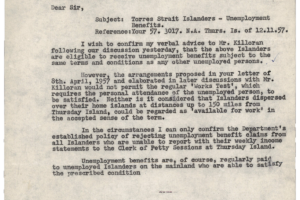
Artefacts about Unemployment Benefit
In 1949, the government rejected requests by 6 Torres Strait Islander cane cutters for Unemployment Benefit. The Queensland Premier asked the prime minister to review the decision.
In 1949, Aboriginal railway labourers who had been denied Unemployment Benefit successfully lobbied the government for financial support.
In the late 1950s, many Queensland Government officials wrote to the federal government arguing for Torres Strait Islander men living on the outer islands to receive Unemployment Benefit.
During a government conference, ministers discussed Aboriginal and Torres Strait Islander people's eligibility for government payments and debated the exclusion of Torres Strait Islander seasonal workers from Unemployment Benefit.
When 23 Aboriginal people stopped getting Unemployment Benefit because they had not taken enough steps to find a job, supporters argued that no jobs were open to them.
During the 1960s, there was increasing pressure for Aboriginal pastoral workers to get equal wages. The government was reluctant to grant Unemployment Benefit payments to Aboriginal workers who were likely to be affected by changes to wages.
In 1965, Aboriginal workers paid at below-award rates could not get government payments. The Federal Council for the Advancement of Aborigines and Torres Strait Islanders raised the issue with government, labelling it ‘coercion’ and ‘discrimination’.
Amendments to this Act in 1966 removed references to Aboriginal people altogether, meaning Aboriginal and Torres Strait Islander people in theory had equal access to government payments. However, discrimination continued.







